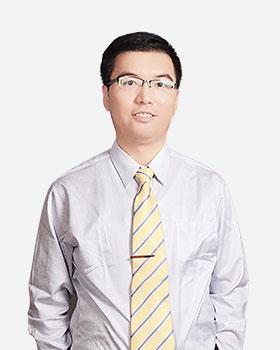Part III. Reading Comprehension (30 points)
Directions: In this section, there are three passages followed by questions or unfinished statements, each with four suggested answers marked A, B, C, and D. Choose the best answer and write the letter of your choice on the ANSWER SHEET.
Passage One
The world’s greatest structures built by insects or animals other than humans are, surprisingly, constructed by termites. Termites, sometimes known as white ants, are little insects that resemble ants in appearance, but they tend to be smaller, fatter, slower moving. There are about twelve to fifteen hundred species of termites. However, not a single one of them belong to the same class of insects as ants. Termites are actually more closely related to cockroaches and mantids. They are known to be social insects that have an instinct to use a system of cooperation and specialization as their main method of survival. Termites are most known to people and scientists for their peculiar and marvelous works of architecture. Australian and African termites, especially, build housing structures reaching almost ten meters in height. Considering their relative size, such a building would be the equivalent of a 200-story edifice for humans. Their knowledge to construct such astonishing structures is known to be inborn in their nature.
The termite nest, or termitary, usually takes the shape of a gigantic mound, or sometimes a multi-fingered hand, rising up from the surface. To build this housing for the colony, termites spend a considerable amount of time. It may take months, or sometimes even a year. The most common material composing a termitary is dirt. Termites carry the local soil and combine it with their saliva to solidify it. Because it is very firm and also impermeable, it is frequently used by people in Africa as a material for building their shelters.
The termitary consists of thousands of chambers, each for a different purpose. The bottom layer of the mound generally serves as the living and working quarter for workers that assume the labors of foraging, food storage, and nest maintenance. Their chambers are located in the lower core so that they can easily go in and out of the termitary in search for food. Some species have gardens of various fungi in this lower part of the nest. The workers are in charge of cultivating and harvesting them as a stable source of food for the young. Above the worker chamber dwell termite soldiers devotedly protect their kind. Soldiers, as a mechanism for fighting, have developed big, strong jaws proportionally too big for their body size. Therefore, they cannot feed themselves without the help of workers. Above these two layers lie chambers called nymphs. The eggs and young termites stay here until they hatch and are fully grown. There is also a room for food storage in this part of the nest. At the top of the mound are the royal chambers for the kings and queens. Any males and females that mate with the opposite sex are termed as kings and queens. Each couple is in different chambers sustaining close proximity all the time. Once a termite has been chosen as a king or queen, such title and responsibility remains for the rest of its life. Unlike male ants which die immediately after mating, termite kings enjoy peaceful lives and are considered just as important as the queen. Queens, at maturity, can lay over a thousand eggs per day.
One of the amazing facts about a termitary is that it comes with the most efficient systems of cooling and ventilation. Walls of the mixture of soil and saliva help keep the nest moist, and thus, cool. Each layer of the mound where a different class of termites resides is vented by a system of passages and ducts, which circulate air throughout because they are connected with parts of the nest in between the layers that have ventilation holes. Thus, the termitary is always maintained cool by having access to a supply of fresh air or light breeze and by allowing stale air to leave. This is very good news for termites, for they will not last even for a few minutes in sweltering conditions. Moreover, termites living in the most arid regions also manage to keep themselves cool by digging into the earth as deep as it is necessary, sometimes resulting in depths over 100 feet. Their task is completed when they reach underground water. This waterway brings a supply of cool and fresh air that rises to the nest and circulates throughout. The gardens tended by workers are also known to aid the cooling process.
1. According to paragraph 1, termites achieve fascinating works of architecture with
A. about twelve to fifteen hundred species.
B. cooperative help from ants.
C. their intrinsic knowledge.
D. numerous trials and errors.
2. It can be inferred from paragraph 3 that termite soldiers
A. cannot fly.
B. fight with their jaws.
C. sometimes search for food.
D. eat termite workers.
3. According to paragraph 3, what is the main difference between royalties of ants and termites?
A. There is only one queen in an ant colony whereas there are many in a termite colony.
B. Male termites that become king live on even after the mating process is over.
C. Queen termites can lay more eggs compared to queen ants.
D. Kings and queens of a termite colony must mate their whole lives.
4. Which of the following can be inferred from the passage about the cooling and ventilation systems in a termitary?
A. They are absolutely necessary for the survival of termites.
B. Supply of air in hot and arid regions will only make the termitary hotter.
C. Water from underground is an essential component of the systems.
D. It cannot work properly without the fungi gardens.
5. Which of the sentences below best expresses the essential information in the italicized sentence in the passage?
A. All passages and ducts in a termitary can be supplied with fresh air because they are hooked up together.
B. Termites punch out ventilation holes in every chamber to obtain direct supply of air in all passages and ducts.
C. Fresh air rising from the underground passages and ducts flows all the way through and cools the termitary.
D. Every layer has ventilation holes that are attached to passages and ducts located outside the termitary where fresh air comes from.
Passage Two
When I accepted a volunteer position as a social worker at a domestic violence shelter in a developing nation, I imagined the position for which my university experience had prepared me. I envisioned conducting intake interviews and traipsing around from organization to organization seeking the legal, psychological and financial support that the women would need to rebuild their lives. When I arrived, I felt as if I already had months of experience, expe rience garnered in the hypothetical situations I had invented and subsequently resolved single-handedly and seamlessly. I felt thoroughly prepared to tackle head-on the situation I assumed was waiting for me.
I arrived full of zeal, knocking at the shelter’s door. Within moments, my reality made a sharp break from that which I had anticipated. The coordinator explained that the shelter’s need for financial self-sufficiency had become obvious and acute. To address this, the center was planning to open a bakery. I immediately enthused about the project, making many refer ences to the small enterprise case studies I had researched at the university. In response to my impassioned reply, the coordinator declared me in charge of the bakery and left in order to “get out of my way.” At that moment, I was as prepared to bake bread as I was to run for political office. The bigger problem, however, was that I was completely unfamiliar with the for-profit business models necessary to run the bakery. I was out of my depth in a foreign river with only my coordinator’s confidence to keep me afloat.
They say that necessity is the mother of invention. I soon found that it is also the mother of initiative. I began finding recipes and appropriating the expertise of friends. With their help making bread, balancing books, printing pamphlets and making contacts, the bakery was soon running smoothly and successfully. After a short time it became a significant source of income for the house.
In addition to funds, baking bread provided a natural environment in which to work with and get to know the women of the shelter. Kneading dough side by side, I shared in the camaraderie of the kitchen, treated to stories about their children and the towns and jobs they had had to leave behind to ensure their safety. Baking helped me develop strong relationships with the women and advanced my understanding of their situations. It also improved the women’s self-esteem. Their ability to master a new skill gave them confidence in themselves, and the fact that the bakery contributed to the upkeep of the house gave the women, many of them newly single, a sense of pride and the conviction that they had the capability to support themselves.
Baking gave me the opportunity to work in a capacity I had not at all anticipated, but one that proved very successful. I became a more sensitive and skillful social worker, capable of making a mean seven-grain loaf. Learning to bake gave me as much newfound self-con fidence as it gave the women, and I found that sometimes quality social work can be as simple as kneading dough.
6. The primary purpose of the passage is to show how the author
A. was shocked by the discrepancy between her earlier ideas about her work and the reality she faced
B. discovered a talent her overly focused mind had never allowed her to explore
C. broadened how she defined the scope of her work
D. developed her abilities to orchestrate a for-profit business enterprise
7. The author was initially enthusiastic about the idea of the bakery because she
A. considered it from a theoretical point of view
B. hoped to obtain a leadership position in the bakery
C. wanted to demonstrate her baking knowledge to her new coordinator
D. believed it would be a good way to build the women’s self-esteem
8. The comparison between baking bread and running political office demonstrates the author’s belief that
A. the bakery would never be a success
B. social workers should not be involved in either baking or politics
C. similar skills were involved in both bak ing and politics
D. she was unqualified for a job baking bread
9. The penultimate sentence in the second paragraph suggests that the author believed that
A. learning the necessary business practices would be a more daunting challenge than learning to bake bread
B. good business practices are more impor tant to running a successful bakery than is the quality of the bread
C. her coordinator’s confidence in for-profit business models was misplaced
D. for-profit business models are signifi cantly more complex than the nonprofit models with which she was familiar
10. The last sentence (“Learning... dough”) indicates that the author
A. found that performing social work is surprisingly easy with no education
B. underestimated her own ability to learn new skills
C. discovered that social work is more effec tive when it includes tactile activities
D. derived a benefit from her work while helping others
Passage Three
For people in Southeast Asian refugee families, the experience of aging in America is very different from what they had expected for their second half of life. Older Southeast Asian refugees must cope with their rapidly acculturating younger family members, while taking on new roles and expectations in a foreign culture.
Many Southeast Asian immigrants are sur prised to find that by American standards, they are not even considered elderly. Migration to a new culture often changes the definition of life stages. In the traditional Hmong culture of Vietnam, one can become an elder at 35 years of age when one becomes a grandparent. With grandparent status, elder Hmong can retire and expect their children to take financial responsi bility for the family. Retiring at 35, of course, is not common in the United States.
There is a strong influence of Confucianism in traditional Vietnamese society. Confucianism, an ancient system of moral and religious thought, fosters strong filial piety and respect for family elders. In many Southeast Asian societies, age roles are hierarchical, with strict rules for social interaction. In America, however, because older refugees lack facility with the English lan guage and knowledge of American culture, their credibility decreases when advising younger family members about important decisions. As younger family members take on primary roles as family mediators with American institu tions—schools, legal systems, and social service agencies, for example—the leadership position of elders within the family is gradually eroded.
Refugee elders must also cope with differences in gender roles in the United States. Even before migration, traditional gender roles were changing in Southeast Asia. During the Vietnam War, when men of military age were away, women took responsibility for tasks normally divided along gender lines. When Vietnamese families came to this country, these changes became more pronounced. There were more employment opportunities for younger refugees and middle-aged refugee women because their expectations often fit with the lower status jobs that were among the few opportunities open to refugees. Many middle-aged women and younger refugees of both sexes became family breadwinners. This was a radical change for middle-aged men, who had been the major breadwinners of the family.
Although the pattern for long-term adaptation of middle-aged and older Southeast Asian refugees is still unknown, there are indications that the outlook for women is problematic. Many older women provide household and childcare services in order to allow younger family members to hold jobs or go to school. While these women are help ing younger family members to succeed in America, they themselves are often isolated at home and cut off from learning English or other new skills, or becoming more familiar with American society. Thus, after the immi grant family passes through the early stages of meeting basic survival needs, older women may find that they are strangers in their own families as well as in their new country.
11. The major purpose of the passage is to discuss
A. the reasons why Southeast Asian people move to the United States
B. educational challenges facing young refugees in America today
C. problems that elderly Southeast Asian people encounter in America
D. changing gender relationships in Southeast Asian refugee families
12. In paragraph 1, “older Southeast Asian refugees must cope with their rapidly acculturating younger family members” refers to
A. middle-aged men’s embarrassment at not being the principal breadwinner
B. middle-aged women’s isolation in the home
C. younger refugees’ better educational and social opportunities in America
D. the tendency of younger refugees to join non-Asian gangs
13. The author uses the term “family mediators” to mean the
A. traditional role of elders in Vietnamese families
B. responsibilities which young refugees assume in a new country
C. help that newly arrived refugees get from friends who migrated earlier
D. professional help available to refugee families in U.S. communities
14. The phrase “radical change” in the last but one paragraph refers to the fact that
A. older refugees find that retirement ages are very different in America
B. women filled men’s jobs during the Vietnam War
C. the education of their children is consid ered crucial by refugee parents
D. refugee men are often displaced as pri mary income earners in their families
15. The author’s point about the problematic long-term outlook for refugee women is made primarily through
A. personal recollection
B. historical discussion
C. case study analysis
D. informed speculation
Part IV. Translation (40 points)
Section A. Chinese to English (20 points): Translate the following into English. Write your translation on the ANSWER SHEET.
一个西方人开始阅读中国哲学著作时,第一个印象也许是,这些作者的言论和著述往往十分简短,甚至互不连贯。打开《论语》,每一小段只包含几个字,各段之间往往也没有联系。打开《老子》,全书只有约五千字,只相当于一般杂志上一篇文章的篇幅,但是老子的全部哲学都在其中了。习惯于长篇大论地进行理性论辩的学生,遇到这种情况,会感到摸不着头脑,不知这些中国哲学家在说什么,由此不免会认为,这些中国哲学家的思想不够连贯。假若真是这样,中国哲学就不存在了。不连贯的思想,怎能称得上是哲学呢?可以说,中国哲学家的言论著述,表面看起来不连贯,乃是由于它们本不是专门的哲学著作。
Section B. English to Chinese (20 points): Translate the following into Chinese. Write your translation on the ANSWER SHEET.
It is important to remember that, in strictness, there is no such thing as an uneducated man. Take an extreme case. Suppose that an adult man, in the full vigor of his faculties, could be suddenly placed in the world, as Adam is said to have been, and then left to do as he best might. How long would he be left uneducated? Not five minutes. Nature would begin to teach him, through the eye, the ear, the touch, the properties of objects. Pain and pleasure would be at his elbow telling him to do this and avoid that; and by slow degrees the man would receive an education, which, if narrow, would be thorough, real and adequate to his circumstances, though there would be no extras and very few accomplishments.
And if to this solitary man entered a second Adam, or better still, an Eve, a new and greater world, that of social and moral phenomena, would be revealed. Joys and woes, compared with which all others might seem but faint shadows, would spring from the new relations. Happiness and sorrow would take the place of the coarser monitors, pleasure and pain; but conduct would still be shaped by the observation of the natural consequences of actions; or, in other words, by the laws of the nature of man.
Part V. Writing (30 points)
Directions: Write a 400-word essay about the issue presented in the following excerpt. DO NOT WRITE ON ANOTHER TOPIC. AN OFF-TOPIC ESSAY WILL RECEIVE A SCORE OF ZERO.
Don’t part with your illusions. When they are gone you may still exist but you have ceased to live.—Mark Twain
In an essay, support your position by discussing an example (or examples) from literature, the arts, science and technology, history, current events, or your own experience, or observations.
点击前往:2022年考研真题及答案汇总专题>>>
相关推荐:
233考研交流QQ群:693804080
考研课程上新中!讲师坐镇,立即听课>>>
233考研题库,超多模拟题等你来刷,真题卷及时更新,立即查看>>>
233考研智能择校工具

微信扫码,30s快速筛选推荐适合你的报考院校!










